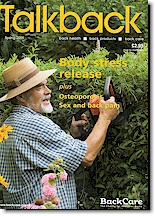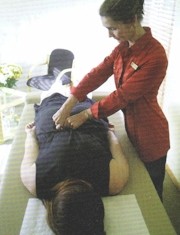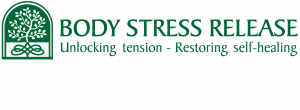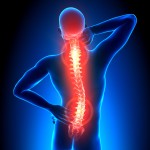Link for latest articles on Body Stress Release on our BSR International website.
|
(NaturalNews) Many people suffer continually with a range of health problems that can often be traced to a stress overload. The human body is designed to be self-healing and continuously attempts to deal with all the stresses to which it is subjected. However, when the point of stress overload is reached, tension can eventually get locked into the body, with the result that pain becomes constant. An individual may eventually accept that feeling less than 100 percent, or living with pain, is a normal condition. Body Stress Release is a relatively new technique, designed to assist the body to release tension.
Who developed Body Stress Release?
Body Stress Release was pioneered by a South African couple, Edwald and Gail Meggersee, in the 1980s, in response to Edwald’s own crippling condition. This included lower back pain and shooting pains in his legs, an ongoing condition which apparently began when he fell from a tree at the age of five. An industrial chemist, Edwald and his wife, a teacher, decided to train in the USA as chiropractors in order to understand and possibly reverse his worsening condition. While doing so, they met a retired chiropractor, Dr. Richard van Rumpt, who had researched a different approach to chiropractic manipulation. He talked about listening to the body and using it as a biofeedback mechanism. The Meggersees returned to South Africa and built on Dr. van Rumpt’s methods.
How does Body Stress Release work?
A Body Stress Release practitioner locates areas of the body where stress is located, using the body itself as a biofeedback mechanism monitor. He or she will then apply light but definite pressure to the sites of body stress. A session usually lasts between 15-30 minutes with the person lying down, fully clothed. Several sessions may be required. Thereafter, bi-annual maintenance sessions are recommended.
Stress may be the result of mental, emotional stress or a traumatic experience, such as a car accident. Bad posture, and/or exercising which strains the body can put considerable strain on the muscles. Not to be overlooked is the attack on the human body from chemical pollutants in food and cosmetics. The body may be unable to tolerate certain chemicals, which in turn gives rise to a physical reaction in the muscles, causing a build-up of body stress.
Body Stress Release practitioners are to be found in many parts of the world, including the USA, Canada, Belgium, the Netherlands, Germany, Iceland, Belgium, Sweden, the UK, Switzerland, Namibia, South Africa, Zambia, Japan, New Zealand and Australia.
Learn more: http://www.naturalnews.c0m/036851_body_stress_release_therapy_pain_relief.html#ixzz2CoQBMyJZ
This month we try…Body Stress Release
Eve Boggenpoel discovers a therapy that gently coaxes your body to release long-held stress and tension
A couple of months ago, someone suggested I try Body Stress Release (BSR). Both my parents were ill and I was working six days a week – I couldn’t have been a more suitable candidate.
BSR practitioners believe that when we are faced with mental. emotional, mechanical or chemical stress, unless we do something about it, the resulting tension remains in the body. ‘Muscles respond in one of two ways,’ says BSR practitioner Peter van Minnen. ‘They can either be supportive, which is their natural design, or adopt a protective mode. When there is excess tension, muscles become “defensive”, effectively creating a splint around the area. And this tension can remain in the body for years after the original trauma.’ Rather than loosen a contracted muscle, as with massage, BSR aims to stimulate the body into releasing in its own time.
At the first appointment, van Minnen makes an assessment of where stress is held by monitoring the body’s response to pressure.
‘What sets BSR apart from chiropractic is that we use muscle testing to determine where the tension is,’ he explains. ‘When I apply slight pressure to an area of tension anywhere in the body, one leg will shorten. If there is no tension, there will be no response.’ leg length is constantly checked throughout the treatment.
To create a healing reaction in the body, practitioners apply gentle, but firm pressure in the opposite direction to the one the muscle is contracting in. ‘We use minimal pressure, so this doesn’t release the tension itself, but it is sufficient to elicit a response in the muscle.’
Sometimes the effect will be immediate, and in other cases, it can take for to seven days. ‘We usually see a complete clearance in three to four sessions,’ he adds.
My treatment is surprisingly short and, although I felt more relaxed, I didn’t really expect it to make much difference. It was while eating supper an hour later that I began to feel its effect.
As I became more relaxed, I began to experience an odd sensation in my arms which made it an effort to lift my knife and fork. I realized it war if I had no muscle tension in my arms.
History
BSR was founded in the 1980s by South African chiropractors Ewald and Gayle Meggersee. At the age of five, Ewald fell out of a tree and was in a coma for a week. Throughout his childhood and early adulthood he suffered severe cramping and shooting pains. Eventually, he lost sensation in his lower body on several occasions. The fear of becoming paralysed made the couple decide to move to the US and train as chiropractors. While there, they met retired chiropractor, Dr Richard van Rumpt, who introduced then to biofeedback, a technique that uses signals from the body to determine treatment options, which they used to develope BSR. As a result of BSR treatment, Ewald, now in his 50s, no longer has pain, and all sensation has returned to his lower body.
Evidence
The therapy is too new to have had any major studies conducted into its efficiency, although there is a large body of evidence in the form of case studies, which can be read on the website (see Resources). Practitioners in South Africa are keen to conduct trials on BSR, so more formal research may be available in the future.
Who should use it?
Van Minnen stresses that BSR doesn’t claim to heal medical conditions, rather it releases tension that may be causing pain or inhibiting the effective functioning of the organ. The most common complaints he works with are back pain, sciatica, headache, neck and shoulder pain, work-related stress and sports injuries. However, he says ‘As most of the population suffers from stress at some point in their lives, the therapy is suitable for anyone, whether it’s a baby with birth trauma, or a pensioner with osteoporosis.’
Contradictions
People who have had a recent operation should wait for three months before having BSR. Pregnant women can be treated but, during the third trimester, extra care will be taken to avoid the diaphragm area. If you have a back problem, van Minnen advises seeing a back specialist for a diagnosis before beginning treatment with him.
Resources
To find a practitioner, visit www.bodystressrelease-uk.co.uk or www.bodystressrelease.com.
Case Study
Artist Richard Hook met Peter van Minnen at a party. ‘I suffered from back problems and had been to an osteopath, but van Minnen could see I still had problems. I made an appointment to see him and, quite simply, I went in with pain and came out without it. Because the nature of my work is stressful, I go to see van Minnen regularly – he puts me right and I feel wonderful. With van Minnen, there’s no crunching and it works.’ From the September 2003 edition of Health & Fitness.
 Managing Pain and Stress
Managing Pain and Stress
with Body Stress Release
Charlotte Richardson-Knott explains the principles of body stress release and how it may be able to help people with back pain.
In my early twenties I started to experience debilitating chronic lower back pain. I knew something was terribly wrong when I began to feel old before my time, that my joints needed oiling, intense early morning lower back stiffness and that my first steps out of bed in the morning resembled more of a penguin shuffle than an actual step.
My lower back became increasingly worse. In a desperate attempt to alleviate the pain I tried all conventional routes of treatment with little success. A colleague introduced me to body stress release. After the first release, I could breathe again, I could move my lower back and I felt a weight lift instantly off my shoulders. With further releases, I started to regain my flexibility and strength as the pain gradually subsided. My energy, enthusiasm and passion for life returned and I knew I had to learn to help others in their quest to ease their pain.
I have been a body stress release practitioner for many years now and delight in assisting people regain their health and vitality whilst empowering them with knowledge and awareness. With stress statistics in the UK reaching record highs, body stress release offers a refreshing, enjoyable and holistic approach to coping with the diverse effects of stress.
Stress and health
We are constantly subjected to various forms of stress in our daily lives. A certain amount of stress is necessary to provide us with challenges and to stimulate us to strive for survival and progress.
 The body, designed to be self-healing, has mechanisms that constantly monitor every function that is taking place. It is continuously adapting to both external influences and stresses and to internal changes and stresses. Health may be defined as ‘the body’s ability to constructively deal with all the stress to which it is subjected’. In this way, it is constantly repairing itself and maintaining its optimum level of efficient functioning. Certain stress factors will cause a temporary reduction in the body’s efficiency or health; for example, a strained muscle will be stiff and painful for a few days and then return to its normal condition.
The body, designed to be self-healing, has mechanisms that constantly monitor every function that is taking place. It is continuously adapting to both external influences and stresses and to internal changes and stresses. Health may be defined as ‘the body’s ability to constructively deal with all the stress to which it is subjected’. In this way, it is constantly repairing itself and maintaining its optimum level of efficient functioning. Certain stress factors will cause a temporary reduction in the body’s efficiency or health; for example, a strained muscle will be stiff and painful for a few days and then return to its normal condition.
Stress overload
Stress becomes a negative, destructive factor in life when it goes beyond the individual’s ability to adapt to it. When the point of stress overload is reached, instead of the stress being released from the body, it becomes stored within the body as ‘body stress’. As we differ in our emotional and physical makeup, we have varying degrees of susceptibility to stress overload.
The causes of stress
Emotional/mental – These include fear of the future, financial worries, competition in the work-place, disintegrating family relationships. At times we experience sudden violent emotions, such as anger or shock, or we undergo milder but ongoing forms of mental strain eg anxiety, depression and resentment. These manifest as problem areas in the diaphragm, jaw, neck, shoulders, as muscles tighten in a defensive posture, to armour is against the onslaught of life’s stresses.
Mechanical stress factors
The body is designed to withstand a certain amount of physical force – bumps, jerks and falls, but if the mechanical stress goes beyond the body’s limit of adaptability the effects may become stored as body stress.
Chemical stress factors
The sources of chemical stress include pollutants in the air, insecticides and certain food additives and preservatives. Harmful chemicals may be consumed, inhaled or even absorbed through the skin.
The effects of body stress
When the point of stress overload is reached, the stress becomes ‘locked’ into the body and manifests as lines of tension. The body adopts a protective mode of action by means of automatic reflexes, causing adjacent and overlying muscles to splint the area. This action has a dampening effect on the nervous system, thereby causing the brain’s filtering mechanism to ignore the areas of body stress. In times when the body is required to take greater defensive action, stiffness may become noticeable ultimately leading to postural distortion, loss of flexibility, pain, numbness and discomfort. A person with body stress may also feel tense, tired and lacking in energy and enthusiasm for life. Headaches, backache and indigestion may follow. It is also possible for the body stress to be present without the individual feeling any pain or stiffness -he or she will simply come to accept as normal their sense of having less than 100 percent well-being.
While the stress or tension remains stored in the body, the normal tone of the body is disturbed, causing a reduction in its general efficiency. As its defense mechanisms become weakened, the body becomes less and less able to deal with further stresses to which it is subjected daily. In this way the individual moves increasingly further away from the optimum state of health.
The Body Stress Release technique
This technique is specifically designed to help the body release all its stored tensions. With the person fully clothed and lying down, the practitioner carries out a series of tests to locate the exact sites of body stress and determines the precise directions in which the lines of tension exist. This is done by applying light pressure to the various points on the body, and observing the response. In this way, the body acts as a biofeedback mechanism supplying the information required. The practitioner then applies a manual stimulus, by means of light but definite pressure, in the exact directions necessary to encourage the body to release the stored tension.
If the body stress has occurred recently, the process of releasing it is usually very rapid. However if the stress has been stored for a long time, the stress releases may have to be carried out a number of times over a period. This is because the tight, protective layers of the muscles tend to relax by degrees back to their normal tone. Since body stress release works with bodies natural striving to be stress free, it is a gentle procedure that does not require force. It does not involve massage, manipulation or the use of any machines or medication.
Practitioners take individual lifestyle factors into careful consideration and offer valuable advice, guidance and monitoring to prevent accumulation of future stress and tension.
Who needs body stress release?
Body stress release is for everyone, from infants to the elderly, whether sick or healthy. As we are all subjected to the stresses of living, we all tend to accumulate stored tension with the resultant decline in the body’s efficiency. Even babies may have body stress after a difficult birth. Therefore everyone’s quality of life may be enhanced, by being assessed for body stress and having it released from time to time. Clients coming for body stress release are usually looking for relief from pain, stiffness, or other discomfort. Whilst body stress release is not a diagnosis or treatment of any specific condition or illness, it assists the body in restoring its self-healing capacity. People have reported improved health relating to a wide range of conditions.
Musculo-skeletal and neurological complaints: lower and upper back pain, sciatica, scoliosis, hip pain, neck pain, whiplash, headaches, migraines, frozen shoulder, bad posture and repetitive strain injury. Gastro-intestinal: heartburn, indigestion, irritable bowel syndrome, constipation, diarrhoea. Emotional problems: stress, insomnia, depression, anxiety, panic attacks and general fatigue. Childhood conditions: colic in babies, poor posture, bed-wetting (enuresis), growing pains in children. Accidents and falls: long term effects of mechanical accidents. Sport: enhanced sports performance.
Wellness
Body stress release also has a broader objective. It is concerned with assisting ‘wellness’ and many people benefit from having regular releases to maintain their health and well being.
A brief history of body stress release
This unique complementary health technique is the result of many years of dedicated research by chiropractor Ewald Meggersee, motivated by his own long history of ill health. Fear of becoming totally paralyzed while still in his early 30’s led Meggersee, together with his wife Gail, to pioneer the body-wellness system known as body stress release (BSR).
Body stress release has been successfully researched and practiced since 1981. As of 2009, there are over 250 qualified body stress release practitioners worldwide, located in Australia, Belgium, Canada, Germany, Iceland, Japan, Netherlands, New Zealand, South Africa, Sweden, United Kingdom and USA. There are currently 30 practitioners in the UK.
Practitioners are passionate about their profession and are strictly monitored and regulated by the International Body Stress Release Association. The association was constituted in 1987 setting international standards in terms of comprehensive training, supervision and continuing professional education and development.
The Body Stress Release Association in the United Kingdom is a member of the British Complementary Medicine Association (BCMA).
I recently had the misfortune of experiencing a very bad fall down a very steep flight of stairs with a particularly bad landing on my sacrum and coccyx. I knew an immediate release was required to address the tremendous shock and reaction felt throughout the entire body. After three releases, within five days I was fully recovered with the confidence of knowing that any long term ill effects had been prevented. I remain forever grateful for body stress release.
Charlotte Richardson-Knott MBSRA BCMA is a BackCare professional affiliate member and body stress release practitioner. From the March 2009 edition of Talkback Magazine.





